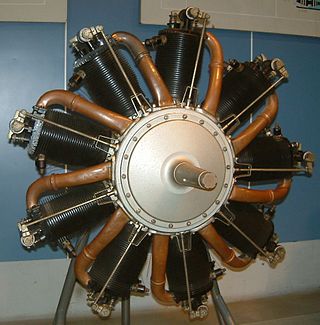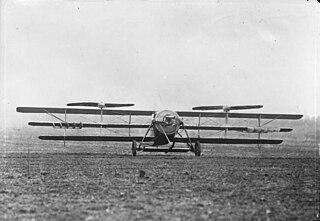Related Research Articles

The rotary engine is an early type of internal combustion engine, usually designed with an odd number of cylinders per row in a radial configuration. The engine's crankshaft remained stationary in operation, while the entire crankcase and its attached cylinders rotated around it as a unit. Its main application was in aviation, although it also saw use in a few early motorcycles and automobiles.

An aircraft engine, often referred to as an aero engine, is the power component of an aircraft propulsion system. Aircraft using power components are referred to as powered flight. Most aircraft engines are either piston engines or gas turbines, although a few have been rocket powered and in recent years many small UAVs have used electric motors.

Emile Berliner originally Emil Berliner, was a German-American inventor. He is best known for inventing the lateral-cut flat disc record used with a gramophone. He founded the United States Gramophone Company in 1894; The Gramophone Company in London, England, in 1897; Deutsche Grammophon in Hanover, Germany, in 1898; and Berliner Gram-o-phone Company of Canada in Montreal in 1899. Berliner also invented what was probably the first radial aircraft engine (1908), a helicopter (1919), and acoustical tiles (1920s).

The Monosoupape, was a rotary engine design first introduced in 1913 by Gnome Engine Company. It used a clever arrangement of internal transfer ports and a single pushrod-operated exhaust valve to replace the many moving parts found on more conventional rotary engines, and made the Monosoupape engines some of the most reliable of the era. British aircraft designer Thomas Sopwith described the Monosoupape as "one of the greatest single advances in aviation".

The Bensen B-8 is a small, single-seat autogyro developed in the United States in the 1950s. Although the original manufacturer stopped production in 1987, plans for homebuilders are still available as of 2019. Its design was a refinement of the Bensen B-7, and like that aircraft, the B-8 was initially built as an unpowered rotor-kite. It first flew in this form in 1955, and on 6 December a powered version, designated B-8M first flew. The design proved to be extremely popular and long-lasting, with thousands of sets of plans sold over the next thirty years.

Le Rhône was the name given to a series of rotary aircraft engines built between 1910 and 1920. Le Rhône series engines were originally sold by the Société des Moteurs Le Rhône and, following a 1914 corporate buyout, by its successor company, Gnome et Rhône. During World War I, more than 22,000 nine cylinder Le Rhône engines were built, with the type far outselling Gnome et Rhône's other main wartime engine series, the Gnome Monosoupape.

The Bristol T.B.8, or Bristol-Coanda T.B.8 was an early British biplane built by the Bristol Aeroplane Company and designed by the Romanian Henri Coandă. Fifty four Bristol T.B.8s were built, being mainly used as a trainer. A small number of Bristol T.B.8s were briefly used as bombers at the start of the World War I by the Royal Naval Air Service.
Charles Benjamin Redrup (1878–1961) was a British aeronautical engineer and inventor, who designed several innovative axial engines.

The Dunne D.8 of 1912 was a tailless swept wing biplane, designed by J. W. Dunne to have inherent stability. One example was supplied to RAE Farnborough. License-built Burgess-Dunne models were used by the US Signal Corps and United States Navy and the short-lived Canadian Aviation Corps. It was the latter's first and only warplane.

The Berliner Helicopter was a series of experimental helicopters built by Henry Berliner between 1922 and 1925. The helicopters had only limited controllability but were the most significant step forward in helicopter design in the US, until the production of the Vought-Sikorsky VS-300 helicopter in 1940. The 1922 flights of the Berliner and the de Bothezat H1 were the first by manned helicopters.

The Gnome 7 Omega is a French seven-cylinder, air-cooled aero engine produced by Gnome et Rhône. It was shown at the Paris Aero Salon held in December 1908 and was first flown in 1909. It was the world's first aviation rotary engine produced in quantity. Its introduction revolutionized the aviation industry and it was used by many early aircraft. It produced 37 kW (50 hp) from its 8 L (490 cu in) engine capacity. A Gnome Omega engine powers the 1912 Blackburn Monoplane, owned and operated by the Shuttleworth Collection, the oldest known airworthy British-designed aeroplane worldwide. A two-row version of the same engine was also produced, known as the Gnome 14 Omega-Omega or Gnome 100 hp. The prototype Omega engine still exists, and is on display at the United States' National Air and Space Museum.

The Gnome 7 Lambda was a French designed, seven-cylinder, air-cooled rotary aero engine that was produced under license in Britain and Germany. Powering several World War I-era aircraft types it was claimed to produce 80 horsepower (60 kW) from its capacity of 12 litres although recorded figures are lower.

The Aero HC-2 Heli Baby is a two-seat general-purpose light utility helicopter, designed by engineer Jaroslav Šlechta, and produced by the Czechoslovak company Aero Vodochody in the 1950s. It has a three-blade main rotor, and a two-blade tail rotor. The helicopter has an entirely metal frame and cockpit, and windows made of Plexiglas. It was the first and the only Czechoslovak-designed helicopter to be produced.

The Rex Smith Biplane was a pioneering biplane based mostly on designs of Glen Curtiss. It was built and demonstrated at College Park, Maryland, at the same airfield that the Wright Brothers trained pilots using their aircraft for the U.S. Army Signal Corps just north of Washington, D.C. This followed the initial demonstration at Fort Myer, Virginia, in 1908 and 1909, when the U.S. Army Signal Corps accepted the Wright Flyer in July 1909. Both the Wright Brothers and Curtiss continued to demonstrate their aircraft at the College Park Airport.

The United States capital, Washington, D.C., has been the site of several events in the nation's history of aviation, beginning from the time of the American Civil War, often for the purpose of promoting the adoption of new aeronautical technologies by the government. It has also been home to several aircraft manufacturers and aviation organizations, and many aerospace contractors have maintained a presence there as well.
Patterson & Francis Aviation Company was an American aircraft manufacturer and repair service in the earliest days of powered flight. The company started as the Patterson Aeroplane Company, based in San Francisco, California.
Joseph Sanders was a German-American who worked alongside his uncle Emile Berliner to develop the record player, the first controllable helicopter and one of the earliest production rotary engines.
Régnier Motor Company was a French aircraft engine manufacturer founded by Émile Régnier in the 1920s.
The Goupy Type B was a staggered biplane designed by Ambroise Goupy in the early 1910s.
References
- ↑ Emile Berliner (November 1913). "Revolving cylinder motors". Aeronautics.
- ↑ "Adams-Farwell Engine" . Retrieved 9 July 2012.
- ↑ The Automotive Manufacturer. 52. January 1911.
{{cite journal}}: Missing or empty|title=(help) - ↑ Aero and hydro America's aviation weekly by Edmond Percy Noël, Aero Club of Illinois: 388. 10 February 1912.
{{cite journal}}: Missing or empty|title=(help) - ↑ John B. Rathbun. Gas, gasoline and oil engines, including complete gas engine glossary. p. 133.
- ↑ Automobile Journal. Vol. 34. p. 68.
- ↑ Aero and Hydro: 198. 14 December 1912.
{{cite journal}}: Missing or empty|title=(help) - ↑ Aeronautics. September 1913.
{{cite journal}}: Missing or empty|title=(help) - ↑ Who's who in the nation's capital. p. 448.
- ↑ Glenn Dale Angle. Airplane Engine Encyclopedia. p. 226.